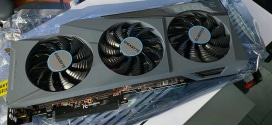ASUS hit the market hard with the little board that packed a big punch. Now they’ve released the bigger brother of that board: the Maximus V Formula, and the Maximus V Extreme is following shortly. Let’s check out the Maximus V Formula and see what it has to offer.
Introduction – ASUS Maximus V Formula
 ASUS and ROG have become synonymous with high end gaming and overclocking enthusiasts. This has come from a lot of marketing activities surrounding overclocking events and gaming sponsorships to show what these models are truly capable of. We have seen a huge amount of ROG boards over our time viewing and using hardware, and we can say that when it comes to the high-end, it’s very hard to beat (or even match) the ROG lineup.
ASUS and ROG have become synonymous with high end gaming and overclocking enthusiasts. This has come from a lot of marketing activities surrounding overclocking events and gaming sponsorships to show what these models are truly capable of. We have seen a huge amount of ROG boards over our time viewing and using hardware, and we can say that when it comes to the high-end, it’s very hard to beat (or even match) the ROG lineup.
We had just recently checked out the Maximus V Gene board which is the mATX version of the ROG gaming lineup boards. At the time that was the only ROG offering for Z77, and rumors abounded of a Formula or even an Extreme variant coming to market. Well we can now say that both rumors are true, as we have both boards for review at our labs.
The Maximus V Formula has some very special features that take it above and beyond what the Gene offered. Some of those features include a completely new SupremeFX offering in the SupremeFX IV, integrated WiFi and even Fusion Thermo VRM cooling to allow for more than capable overclocking headroom. All of this plus more comes together to make for a serious contender for a top gaming board.

We know the Maximus V Formula is quite the step up in size from the Maximus V Gene. With that we will take a look at what this board offers in terms of performance and features to help determine how well it merits you spending the extra cash on this board versus its many competitors. The retail price for this board at time of writing is $279.99 at Newegg.
Key Features
APS (ASUS Premium Service)
ASUS Previously offered the APS service on ROG boards, but starting with the X79 series they have extended the service to cover much more of their X79 models in the standard channel line. This is nice to see as the APS service allows an advanced replacement or a board to be shipped to the user which in turn means less down time for the end user. More on this service can be seen on the ASUS website HERE
Windows 8 Ready
ASUS has been hard at work prepping for Windows 8, the new revolutionary OS from Microsoft. With this comes a new BIOS CAP file which is said to improve features and fucntionality integration for better compatibility with the new OS. Other cool features include faster boot up times and optimized settings for a smooother Windows 8 working environment. We’re sure the features available for this upgrade will scale larger as the OS matures and becomes available so keep a lookout at the ASUS site for updates found HERE
mPCI-E Combo Card (WiFi/BT 4.0 mPCI-E card included)
ASUS included a Mini PCI-E and mSATA card with the Maximus V Gene, but with the Formula they did one better. With this board, ASUS decided that just having the mini PCI-E option wasn’t enough and they wanted the board to have WiFi to add to its many unique features. With that ASUS bundles a mini PCI-E WiFi/BT4.0 modules preinstalled on the small card. This alone allows for WiFi function and near-universal wireless functionality. Additionally, an mSATA SSD can be installed with capacities up to 240GB which means a complete and almost wireless system can be installed with no storage devices even plugged into the onboard SATA ports. We like this as it allows for some amazing versatility as to how you want your system configured.
Fusion Thermo VRM Cooling
ASUS has quite a history of Fusion liquid cooling solutions for their chipsets on their performance ROG boards. They have always supported full air cooling with the option to add liquid cooling for even better thermal efficiency. The Maximus V formula has the option but does not make that your only option as you see in the image that running parallel to the liquid pipe the Fusion thermo solution also has a standard heatpipe to allow full air cooling capability should you choose to not liquid cool the VRM.
ASUS shows here how the Fusion Thermo works, which is much like any basic watercooling device. It simply passes liquid through the heatsink pipe which transfers heat away from the heatsink/critical components through the water into the watercooling radiator.
Here we see the comparison direct from ASUS along with thermal imaging showing the difference between the aircooled Fusion Thermo heatsink and the same block and load with the liquid cooling plumbed to it. I do not have a Thermal camera to verify but my extensive background in liquid cooling tells me that this is not a stretch by any means as liquid assisted cooling tends to work very well.
Lucidlogix Virtu MVP
ASUS like all other manufacturers offers the Lucidlogix Virtu MVP support for their Z77 line which is a very interesting improvement over the previous lucid virtu we had used before. This version of Virtu MVP does all of the same functions that the original could do but is better optimized, and now adds some new 3D enhancement features to the mix that make for a very interesting possible implementation. Virtu MVP offers HyperPerformance which allows for rendering to be offloaded to the iGPU and in turn allows the discreet GPU to do the grunt work it was designed for while the iGPU does the light frame renders to ensure better fps as the frames are pre rendered in place and any duplicate frame is not rendered by the discreet GPU and is dropped by the discreet GPU to keep the discreet GPU processing only frames which are new or different than the previous.
Also included in the MVP package is Virtual Vsync which allows for the tear free quality of vsync display without being limited to the display refresh rate which ultimately will allow for smoother performance and playback. This is accomplished by the same methods as mentioned above by pre rendered frames and dropping partial rendered frames before they get to the discreet GPU to avoid from partial redraws which will cause the undesired tearing affect we have seen before.
Further in this review we will do some game testing to find what exactly we get from Virtu and if the performance is worth the hype.
ASUS GameFirst II
ASUS has pushed the Gamefirst technology even further with its cFos software which now offers a EZ mode to allow even easier tweaking and adjust ability for all end users to increase online gameplay performance. The Gamefirst II technology builds off of the ability to shape the network traffic to better control throughput and packet priority to ensure the program that needs maximum speed and reduced latency such as streaming HD video or simply online gaming is all at your fingertips.
USB BIOS Flashback
ASUS offers the BIOS Flashback utility which is actually a multi-facet tool and has many capabilities which some may not be aware of. we have had many times where a motherboard did not support a CPU and a frantic search for a supported CPU just to flash the BIOS (ex. Gulftown CPU support on X58). ASUS has eliminated the worry of these kinds of issues by allowing the BIOS flashback procedure which does not require a CPU or memory to flash the BIOS. All that is needed in order to flash the BIOS is to have the desired firmware ROM file on a USB thumb drive and insert that into the ROG connect USB port.
Depressing the ROG Connect button for 5 seconds will start a flashing LED which indicates the firmware is being updated and once the update is complete the flashing will stop. It really is that easy and ensures no matter the condition the firmware can be flashed even if the newest CPU is not supported without the previously mentioned hunt for a compatible CPU.
This may seem like an odd feature but many may buy the newest and greatest CPU on the market while the board could have been shipped with the older firmware which in most cases would leave the user stuck without an option. As for our usage we have found this useful in quite a few experiences where running a LN2 cooled system not necessarily in the most stable conditions and a BIOS had gotten corrupt, but with the BIOS flashback it was remedied as quickly as we could copy the Rom file from our laptop to the flash drive and get it flashing.
USB 3.0 Boost
Turbo USB is a new feature we have seen from ASUS as of recent and it allows for a speed increase from older USB 2.0 thumb drives or storage devices when the Turbo mode is enabled on that device through the ASUS AISUITE II software.
One thing that not many have publicized is the fact that this boost also supports a protocol called UASP which supports a much higher transmission rate via the Asmedia controller. ASUS included with the motherboard a Thermaltake BlacX 5G USB 3.0 capable external docking station along with a Corsair Force GT SSD to allow for testing of this feature. we went ahead and tested multiple different drives and combinations to see how the functions actually plays out in real world scenarios.
Keep in mind that this is not just for external docks as any USB storage device can possibly be sped up via the USB 3.0 boost even USB2.0 thumb drives may grab a small advantage from being plugged into the USB3.0 port and having the boost enabled.
For more information please see the ASUS USB 3.0 Boost landing page here
Supreme FX IV
SupremeFX IV is the next iteration past the SupremeFX III we saw on the Maximus V Gene just not to long ago. This is not necessarily reinventing the wheel here, but more just improving it for an even better gaming experience.
Here we see the basic overlay of the main components and features of the SupremeFX IV audio module. Something we have seen before is the “red line” shielding which is an island in the PCB with blank PCB space separating the audio components from the rest of the board to ensure minimal interference from the digital board components getting into the Analog audio circuits. This blank PCB is also backlit by red LED’s to show off the red PCB separation line.
The EMI protection shield is also backlit and is in place to block EMI from getting to the audio codec and causing stray noise from ruining your audio experience.
Top quality audio caps are used in the SupremeFX IV audio solution to allow for the cleanest possible audio from the onboard solution. This is all designed around the idea of providing the best possible gaming environment for you the end user. We can say that from our testing the audio quality is very good.
Once again something we have seen before are high quality and high power headphone amps built onboard. The Formula boards’s SupremeFX IV solution does not disappoint with a 300ohm amplifier for excellent performance from high end gaming headsets.
Here we see more detail covering the separation of the “red line” PCB as the audio solution has its own island of PCB. This effectively isolates the audio circuit from any sort of crosstalk or noise from the digital to analog circuits. Also illustrated is the PCB layer separation and how it works to ensure every possible step has been taken to ensure noise free audio.
Here we see some detail about the high end audio caps and how they help filter the audio for not just elimination of the peaky highs but to ensure bottomless low end as well. Also detailed here is the 300ohm headphone amplifier designed to ensure maximum audio power makes it to your high end gaming or even studio music headset.
Here ASUS shows the lossless audio of the SupremeFX IV solution compared to a standard audio solution found on some other models.
Extreme Engine Digi+ II
The Digi+ solutions have been a mainstay on ASUS boards for some time now. For the ROG models the Extreme engine Digi+ solutions are selected from very top components to ensure overclockability and constant load performance is never a matter of compromise. We have covered the Extreme Engine Digi+ components many times previously and the same carries over with full digital Digi+ controllers, solid state black Nichicon GT caps and top shelf mosfet components.
GPU/Dimm Post
GPU/DIMM POST is one of those features whose benefit usually will be seen in the most stressful times like when something is not working. We actually wound up using this feature without intention on a previous ROG review, when a 32GB memory kit we were testing only showed up as 24GB. As we entered the BIOS after several attempts to fix the problem, we checked the GPU/DIMM POST and found that 2 modules were reading as “abnormal”. Powering the system off and resetting those DIMMs remedied the issue, but seeing that info directly in the firmware can save a lot of time when diagnosing errant behavior or instability; this kind of information being readily available is an invaluable asset to users. Additionally, the GPU POST option allows us to see the installed GPU’s in each slot, so that when benching LN2 or even on a liquid cooled gaming rig, the GPU POST screen can be checked to ensure identification of all installed cards is accomplished. See the BIOS Section for more info.
Fan Xpert 2
ASUS has always had Fan Xpert technology as part of its AISuite utility chest but its always been used for manual adjustments and profiling of the system fans.
The Fan Xpert 2 now comes with a automatic profiling system which we will attempt to demonstrate in the following.
Here is the main screen where you can select between custom fan profiles such as Silent which spins down all fans except the CPU cooling fan. The Standard profile specifies a standard throttling setting for fans depending upon temperatures, and lastly we have the Turbo mode which throttles every fan up for maximum cooling when needed.
Pressing the “Fan Auto Tuning” button will start the motherboards intelligent learing process which we see below.
Here we see as the fans are proceeding through the automatic tune process. The fans are ramped to maximum then gradually ramped down to stopping at which point the motherboard knows where the stop and start point for every fan connected to the motherboard would be and this helps the motherboard better tune the system for an optimum airflow/noise ratio.
After the analysis is complete the fan Xpert screen moves to the next and final step which is where you select where each detected fan is on the chassis. if you are not sure you can always click the “Search” button to the right and the system will spin all fans down and it will spin the selected fan only up to maximum speed so that you can identify its position and even name it. This as well will help with the cooling setup and how the system throttles each fan independently.
 Bjorn3D.com Bjorn3d.com – Satisfying Your Daily Tech Cravings Since 1996
Bjorn3D.com Bjorn3d.com – Satisfying Your Daily Tech Cravings Since 1996






























I wanted to get a Maximus series ROG board but they just coast too much 350+ at the time. I decided to go with a cheaper priced board. I like the marketing spin for the red line.